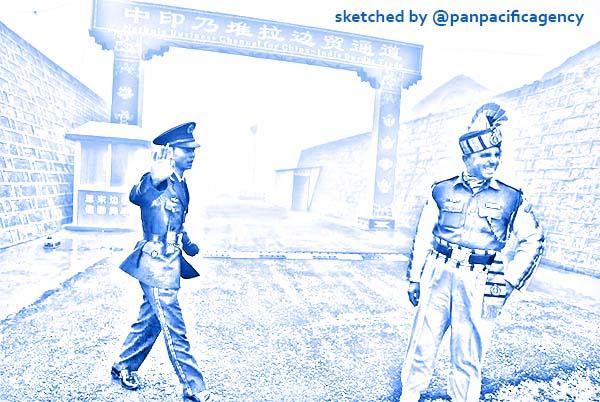Chinese troops have dismantled camps on disputed India border: Satellite images

A Chinese soldier (L) and an Indian soldier (R) stand guard at the Chinese side of the ancient Nathu La border crossing between India and China. Photo: AFP/Diptendu Dutta. Sketched by the Pan Pacific Agency.
NEW DELHI, Feb 18, 2021, CNN. China has withdrawn troops, dismantled infrastructure and vacated camps along its disputed border with India, according to new satellite images — just a week after both countries agreed to a mutual disengagement, CNN reported.
Satellite images taken on January 30 by US-based Maxar Technologies showed a number of Chinese deployments along Pangong Tso, a strategically important lake that runs across the two nuclear powers’ de facto border, known as the Line of Actual Control (LAC). In new images taken on Tuesday, dozens of vehicles and building structures had been removed, leaving empty land.
China announced on February 10 that both countries had agreed to disengage along the south and north shores of the lake.
“The Chinese have shown their sincerity of intent of purpose in carrying out the disengagement process,” Indian Lt. Gen. YK Joshi told CNN affiliate CNN-News18 on Thursday. “They have been doing it at a very rapid pace.”
Images and footage released by the Indian Army on February 10 showed excavator trucks and loaded convoys, Chinese soldiers dismantling tents and carrying bags out of camp, and People’s Liberation Army (PLA) tanks on the move.
Wang Wenbin, a spokesperson for China’s Ministry of Foreign Affairs, said Beijing hoped India would “work with China to meet each other halfway.”
Indian Defense Minister Rajnath Singh told Parliament on February 11 that both sides would “remove the forward deployment in a phased, coordinated and verified manner.”
The agreement was reached at a ninth round of talks between the two sides, which have been ongoing since a deadly clash between Indian and Chinese troops at the border last June.
Under the “mutual and reciprocal” disengagement terms, China will maintain troops in the north bank area to the east of a deployment known as Finger 8, while Indian troops will maintain a permanent base near a deployment known as Finger 3, said Defense Minister Singh. Both sides will take a “similar action” in the south bank, he added.
Any structures built by either side after April 2020 will be removed, and all military activities will temporarily halt on the north bank, including patrolling. Modifications to the land, like dugouts and trenches, will also be removed, according to Joshi.
Once disengagement has been completed, senior commanders from both sides would meet within 48 hours to discuss remaining issues, Singh said.
The 2020 border clash
India and China share a 2,100 mile-long (3,379-kilometer) border in the Himalayas, but both sides claim territory on either side of it.
Pangong Tso, located some 14,000 feet (4,267 meters) above sea level, spans an area stretching from the Indian territory of Ladakh to Chinese-controlled Tibet, in the greater Kashmir region where India, China and Pakistan all claim territory.
In 1962, India and China went to war over this remote, inhospitable stretch of land, eventually establishing the LAC — but the two countries do not agree on its precise location and both regularly accuse the other of overstepping it, or seeking to expand their territory. Since then, they have had a history of mostly non-lethal scuffles over the position of the border.
But violence erupted last June when at least 20 Indian soldiers were killed during a hand-to-hand clash near Pangong Tso, marking the deadliest border conflict in more than 40 years. China has never acknowledged any casualties from that incident.
In September, China and India agreed to stop sending more troops to the border, following an escalation in tensions between the countries. The situation was temporarily resolved, with the two sides engaging in several rounds of talks.
The latest round of talks, which led to the agreement to disengage, came after the Indian Army said there was a “minor” face-off between Indian soldiers and China’s PLA near the border last month. It was “resolved by local commanders as per established protocols,” the Indian Army said in a statement, without providing detail on any injuries.
China is doubling down on its territorial claims and that's causing conflict across Asia
China is doubling down on its territorial claims and that’s causing conflict across Asia
“Our aim is that there should be disengagement and stability at the LAC so that peace and tranquility can be established properly,” said Singh in his statement to Parliament. “We hope this will restore the situation to that existing prior to commencement of the standoff last year.”
But some experts argue that this disengagement alone does not restore the status quo, and that there are still unresolved points of friction between the two countries in other parts of the LAC.
“I don’t think we are going to go back to square one,” said Manoj Joshi of the Observer Research Foundation, a New Delhi-based think tank. He added that there are “other strategic points” under dispute like the Galwan Valley in Ladakh, and that China has continued to aggressively build up its presence along various parts of the border.
“This disengagement is limited to the Pangong area,” he said. “But it is about what we see in other areas. There are other strategic points … We need to be cautious about how this plays out.”